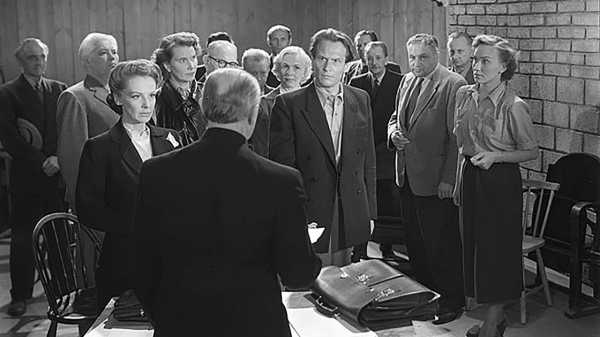
The rarely screened, recently restored film by Ingmar Bergman, “This Can’t Happen Here” (a.k.a. “High Tension”), from 1950, goes far to answer common musings from the cinematic water cooler—speculations about what would happen, or would have happened, had art-house directors of the classic age made Hollywood studio films, action films, genre films. The answers aren’t entirely unknown: Fritz Lang worked in Hollywood for twenty years; Jean Renoir and Max Ophüls worked there in the forties. But Bergman’s art is a special case, involving an extremely personalized unity of style and substance. And “This Can’t Happen Here,” which is playing at MOMA through Tuesday, shows what happens when that unity is sundered.
It’s a political drama based loosely on historical events, and its approach to them is cagily defined in an opening voice-over, which affirms that the film’s details are fictional. “Any resemblance to anything real is, therefore, not due to coincidence,” it adds. The film follows refugees in Sweden who have fled the fictitious nearby country of Liquidatzia, a “modern dictatorship,” but are still facing threats there from that tyrannical government’s undercover agents. The story (written by Herbert Grevenius, a theatre critic who was Bergman’s friend) is rooted in actual events—the desperate efforts of residents of the Baltic states to flee Soviet occupation and annexation and to remain safely in Sweden—but it’s set up in a matched pair of conventional genres. One, the spy thriller, was alien to Bergman’s own artistic inclinations; the other, the romantic drama, was at the heart of it.
An ostensible engineer, Atkä Natas (Ulf Palme), a man approaching middle age, returns to Stockholm from Liquidatzia, inconveniencing his wife, Vera Natas (Signe Hasso), a research scientist who is having an affair with a police officer named Björn Almkvist (Alf Kjellin), who doesn’t quite understand why she plans to reunite with her husband. The reason emerges quickly: Atkä is an agent for the government of Liquidatzia, one of many who are attempting to terrorize, dupe, kidnap, and forcibly repatriate émigré dissidents—including Vera, who is now using her marriage as cover for her own resistance plot. But, in the process, she risks endangering other members of the Liquidatzian refugee community, who suspect that Vera herself may be an infiltrator. Though the Swedish police officially abstain from involvement in the affair (remaining, so to speak, disturbingly neutral in a matter where justice is clearly on one side), Almkvist, finding Vera in danger, takes matters into his own hands.
From the start, Bergman achieves an almost unbearable sense of dramatic tension using signature devices, including overwhelming closeups, highly inflected angles, and distortingly expressive points, streaks, and outlines of light and depths of shadow, as well as disturbing incongruities. (The Natases live above a theatre, where the lighthearted and rambunctious rehearsals provide a backdrop for their tense maneuvers, and a group of refugees from Liquidatzia meet in a backroom of a movie theatre where a Disney cartoon plays while they confront matters of life and death.)
But the film’s expressionistic and theatre-centered elements are vitalized, as so often throughout Bergman’s career, with a nearly documentary attention to place. The “here” of “This Can’t Happen Here” is unambiguous and detailed; Bergman, working with the cinematographer Gunnar Fischer (as he did throughout the nineteen-fifties) films Stockholm locations with a devotion that rivals his attention to the actors. These sequences, filmed in extended time, as in a shot at a loading dock or another of a shipment leaving a theatre (observed from a rooftop), offer a fury of suspense evoked with a chilling sparseness, lending the film a hectic, paranoiac sense that the most ordinary of city views are imbued with historic and pullulating evil.
“This Can’t Happen Here” is, in short, a good movie—but, revealingly, in interviews and writings, Bergman repudiated it. He said that he kept a print of most of his films, but not of this one; he refused to allow it to be screened in retrospectives of his work. He discusses it at length in the interviews from 1968 (by Stig Björkman, Torsten Manns, and Jonas Sima) published as “Bergman on Bergman.” He says that he made it only for the money, and that the experience was miserable, due in part to the illness of its star, Signe Hasso, which made her hard to work with through no fault of her own, and then due to his own illness throughout the filming. But, above all, what made him miserable was his realization, in the course of the filming, that he was making the wrong movie. Many of the actors playing refugees from Liquidatzia were actual refugees from the Baltic states, and, Bergman said, “To them what we were just playing at was grim reality!”
Bergman wasn’t embarrassed by the movie’s politics. In the interview, he spoke of “the Baltic refugees, and all the humiliations they were exposed to, both by us Swedes and the Russians. That’s something I’d really like to take up some day.” (A footnote explains that the Swedish government acceded to Soviet demands for the forcible repatriation of some Baltic refugees.) Rather, he was embarrassed by the movie’s emphasis, its trivialization and effacement of the experience of the actual protagonists. In his 1990 book, “Images,” he said, “Among these exiled actors I discovered such a richness of lives and experiences that the unevenly developed intrigue in ‘This Can’t Happen Here’ seemed almost obscene.” He asked the studio head to stop production, but his request was in vain.
Bergman was one of the great cinematic innovators of his time. What made him so was more than his unsparingly frank sensibility, more than his visual imagination, more than his ferociously anti-romantic romantic vision and his post-religious religious vision. Despite his extensive theatrical training, Bergman didn’t direct actors as much as he filmed people. One of the central aspects of his radical modernity and his enduring influence is his breaking of the boundary between performance and performer, between actor and person; his movies are recordings of personal relationships. The actors in “This Can’t Happen Here” are nuanced, vigorous, subtle. Hasso is tautly controlled and offers shivers of righteous passion with minimal fuss.
But to compare the performances in “This Can’t Happen Here” with those that Bergman achieved in films that he made just before and soon after it, “Summer Interlude” (starring Maj-Britt Nilsson) and “Summer with Monika” (starring Harriet Andersson) is to see the difference between highly refined craft and daring, dangerous originality. Unlike the performances in those more personal films, the ones that Bergman elicits in “This Can’t Happen Here” aren’t imbued with the actors’ vulnerability, spontaneity, and confrontational energy, or with the intimacy and immediacy of Bergman’s own observations. “This Can’t Happen Here” would be to the credit and honor of almost any director of the time—other than Bergman.
Sourse: newyorker.com






